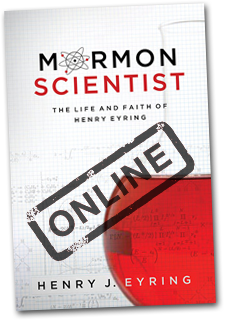Featured Book Review
Line Upon Line, Precept Upon Precept
“You’ve got to write your grandfather’s story,” Elder Neal A. Maxwell explained to Henry Johnson Eyring on numerous occasions. Eyring felt that he was not capable of producing such a piece of work, but after much faith, determination, and research, we now have “Mormon Scientist”, the biography of world-renowned chemist and scientist Henry Eyring. Henry Eyring was a master of paradoxes, and as such, he was able to fuse science and his faith and membership in The Church of Jesus Christ of Latter-day Saints. Many see his paradoxical way of living and thinking as contradictory, but in reality, it made him a great bridge builder and a very powerful communicator. The book highlights the communication challenges that arise from extreme positions such as science-only or religion-only. In other words, the book’s theme is the trouble caused by ideas that seemed opposed and beg their adherents to disprove the seemingly opposing idea. The book describes how Henry was able to overcome these apparent rivals by being on both sides, seeing the truth in both.
The book clearly identifies Henry’s reasoning in believing both in religion and in science, even when they seemed to conflict. To put it short, Henry believed what scriptures teach when they say, “For behold, thus saith the Lord God: I will give unto the children of men line upon line, precept upon precept, here a little and there a little; and blessed are those who hearken unto my precepts, and lend an ear unto my counsel, for they shall learn wisdom; for unto him that receiveth I will give more; and from them that shall say, We have enough, from them shall be taken away even that which they have.” (2 Nephi 28:30) Henry believed that neither science nor religion is complete, so we don’t have all of the answers to the puzzle. He lived his life believing that both are compatible, but that what we know is most likely not the entire truth.
All in all, Mormon Scientist conveys the peculiar man who is Henry Eyring. Henry did many things that in most circumstances would seem like career suicide, such as leaving Princeton for the University of Utah, but by reading one comes to see how Henry was doing things for the greater good. By studying the book, the reader will have a greater understanding and appreciation of both religion and science and will be able to see that they literally are compatible.
